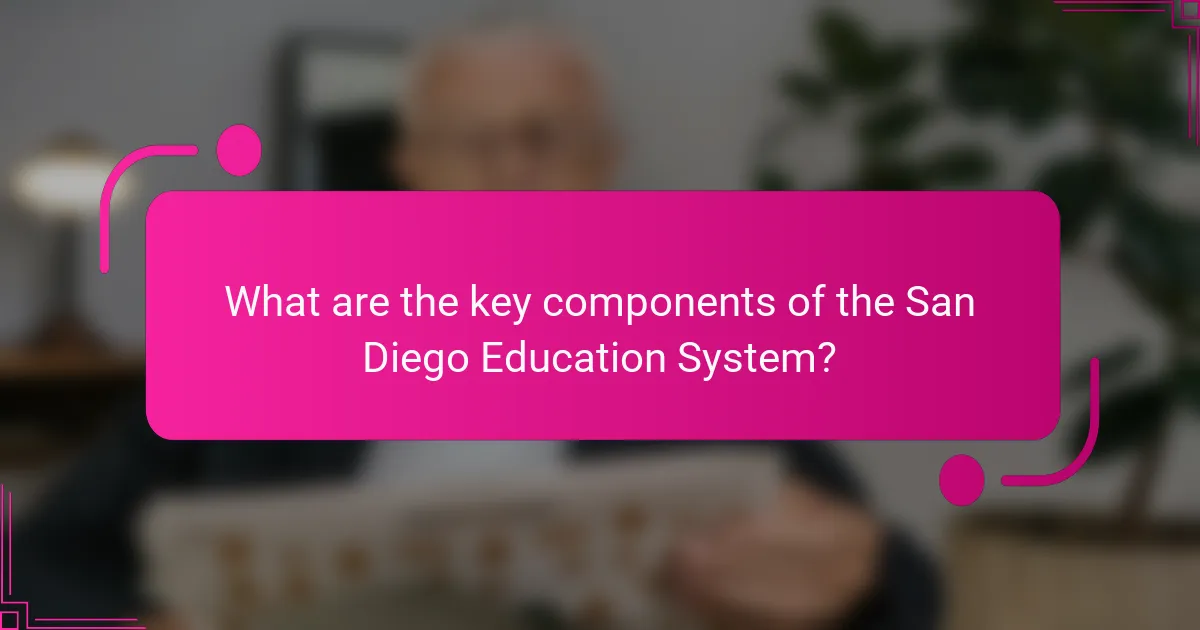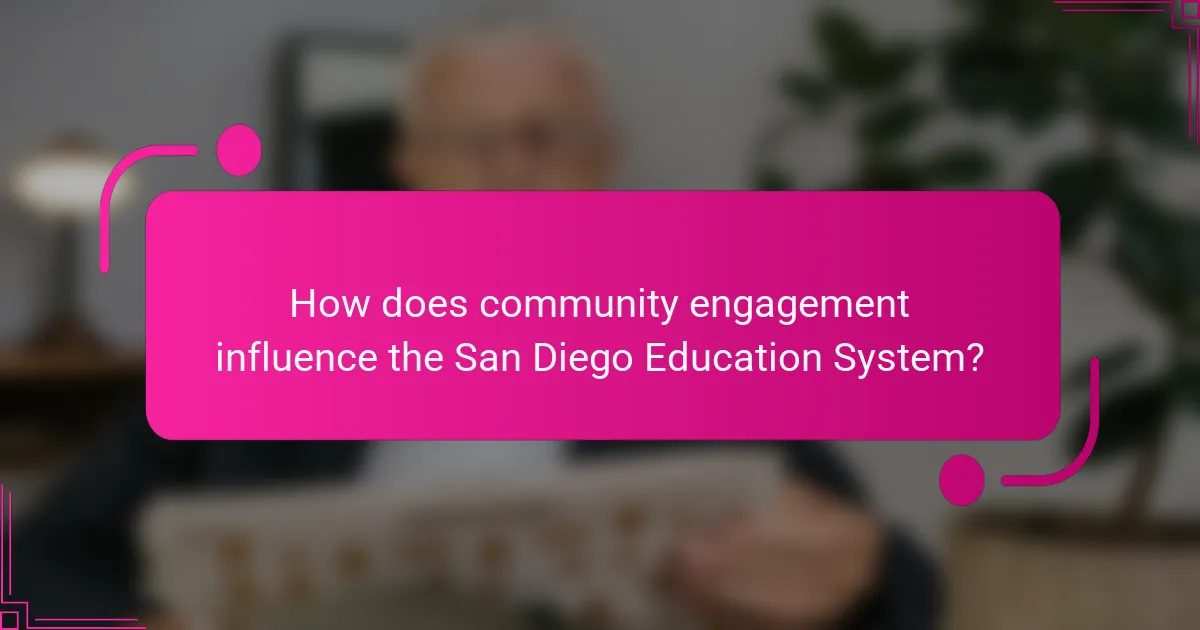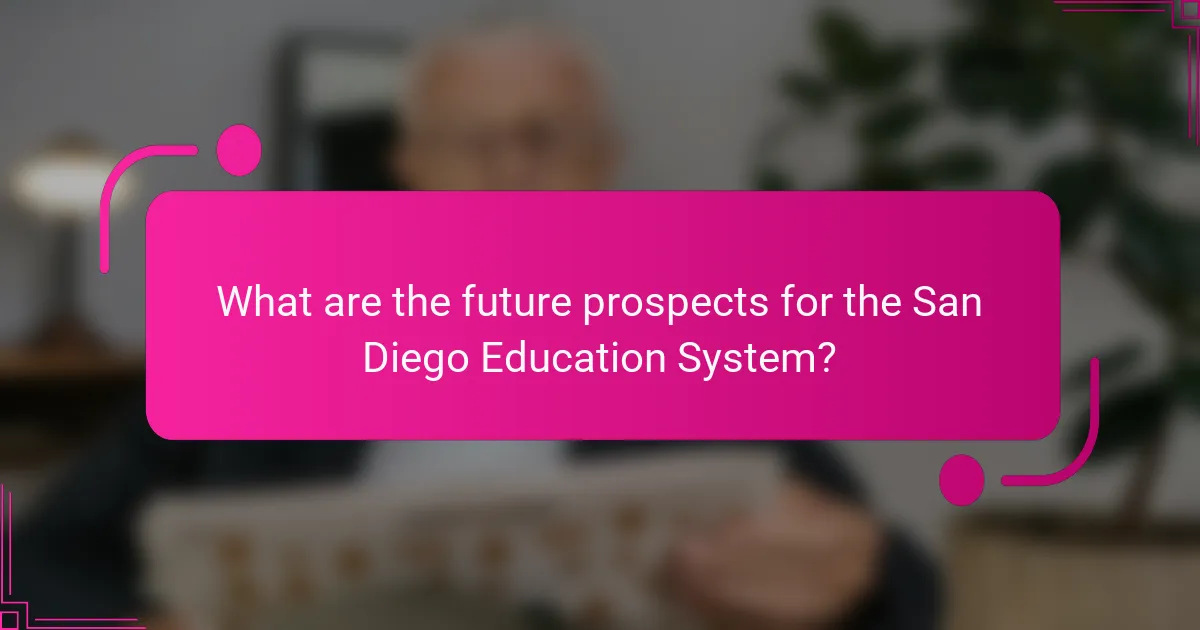
What are the key components of the San Diego Education System?
The key components of the San Diego Education System include public schools, charter schools, and community colleges. Public schools serve the majority of K-12 students in the area. The San Diego Unified School District is the largest district, with over 100,000 students enrolled. Charter schools offer alternative education options and promote innovative teaching methods. Community colleges provide accessible higher education and vocational training. These institutions collaborate with local organizations to enhance educational opportunities. The system also emphasizes community engagement through programs and partnerships. Overall, these components work together to support diverse educational needs in San Diego.
How is the San Diego Education System structured?
The San Diego Education System is structured into several key components. It primarily consists of public K-12 schools, charter schools, and private institutions. The San Diego Unified School District oversees the majority of public schools in the area. This district includes elementary, middle, and high schools, serving a diverse student population.
In addition to traditional schools, there are numerous charter schools that offer alternative educational approaches. These schools operate independently but are funded by public money. Private schools also exist, providing various educational options outside of the public system.
The system is supported by local, state, and federal funding. California’s education funding formula allocates resources based on student enrollment and specific needs. Community engagement plays a significant role in shaping educational policies and programs. Parents and local organizations often collaborate with schools to enhance student learning experiences.
Overall, the San Diego Education System is a multifaceted structure that aims to meet the educational needs of its diverse community.
What levels of education are included in the San Diego Education System?
The San Diego Education System includes several levels of education. These levels are preschool, elementary school, middle school, high school, and post-secondary education. Preschool serves children typically aged 3 to 5 years. Elementary schools cater to grades K-5. Middle schools encompass grades 6-8. High schools cover grades 9-12. Post-secondary education includes community colleges and universities. Each level plays a crucial role in the overall educational framework of San Diego.
What are the roles of various stakeholders in the San Diego Education System?
The roles of various stakeholders in the San Diego Education System include educators, administrators, parents, students, and community organizations. Educators develop and deliver the curriculum to ensure student learning. Administrators manage schools and oversee educational policies and resources. Parents provide support and engagement in their children’s education. Students actively participate in learning and provide feedback on their educational experience. Community organizations offer resources and programs that enhance educational opportunities. Each stakeholder plays a vital role in fostering a collaborative environment aimed at improving educational outcomes.
What challenges does the San Diego Education System face?
The San Diego Education System faces several significant challenges. One major issue is funding disparities, which affect resource allocation across schools. According to a report by the San Diego Unified School District, many schools struggle with inadequate facilities and outdated materials. Additionally, there is a high level of student mobility, impacting stability and continuity in education. The district also grapples with a teacher shortage, particularly in specialized subjects like math and science. Furthermore, the achievement gap among different demographic groups remains a persistent challenge. These factors contribute to difficulties in providing equitable education for all students in the district.
What are the funding issues affecting the San Diego Education System?
The San Diego Education System faces significant funding issues primarily due to budget cuts and inadequate state funding. These financial constraints lead to larger class sizes and reduced resources for students. According to the San Diego Unified School District, funding per student has decreased by approximately 10% over the past decade. Additionally, the reliance on local property taxes creates disparities in funding across different neighborhoods. Schools in wealthier areas receive more funding compared to those in lower-income regions. This inequity affects the quality of education and available programs. Furthermore, the ongoing impacts of the COVID-19 pandemic have exacerbated existing financial challenges, leading to increased operational costs. Overall, these funding issues hinder the ability of the San Diego Education System to provide equitable and quality education for all students.
How does student diversity impact the San Diego Education System?
Student diversity significantly impacts the San Diego Education System by enriching the learning environment. Diverse student populations enhance cultural awareness and promote inclusivity among peers. This diversity encourages collaborative learning and fosters critical thinking skills. According to the San Diego Unified School District, approximately 50% of students identify as non-white. This demographic shift necessitates curriculum adaptations to reflect varied cultural perspectives. Furthermore, diverse classrooms improve social-emotional learning by teaching empathy and respect for differences. Research shows that schools with diverse student bodies often perform better academically due to increased engagement. Overall, student diversity is a vital component in shaping an effective educational framework in San Diego.
What innovations are being implemented in the San Diego Education System?
The San Diego Education System is implementing several key innovations. These include the integration of technology in classrooms. Schools are adopting digital learning platforms to enhance student engagement. Personalized learning approaches are being utilized to cater to individual student needs. Additionally, partnerships with local organizations are fostering community involvement in education. The district is also focusing on social-emotional learning programs to support student well-being. These innovations aim to improve academic outcomes and prepare students for future challenges.
How are technology and digital learning being integrated into the San Diego Education System?
Technology and digital learning are being integrated into the San Diego Education System through various initiatives. Schools are adopting blended learning models that combine traditional teaching with online resources. This approach enhances personalized learning experiences for students. The district has implemented a one-to-one device program, ensuring each student has access to a laptop or tablet. Additionally, online platforms are being used for assessments and curriculum delivery. Teacher training programs focus on integrating technology into lesson plans. Partnerships with tech companies provide resources and support for digital learning initiatives. Recent data shows improved student engagement and performance due to these integrations.
What are some successful programs or initiatives in the San Diego Education System?
The San Diego Education System has several successful programs and initiatives. One notable initiative is the “San Diego Unified School District’s (SDUSD) Dual Language Immersion Program.” This program promotes bilingualism and biliteracy in students. It serves both English and Spanish-speaking students. Research shows that dual language programs improve academic performance and cultural awareness.
Another successful program is the “San Diego Promise.” This initiative offers free community college tuition for eligible high school graduates. It aims to increase college access and completion rates. Data indicates that the program has significantly boosted enrollment in community colleges.
The “STEM (Science, Technology, Engineering, and Mathematics) Initiative” is also noteworthy. This initiative enhances STEM education in local schools. It encourages hands-on learning and critical thinking skills. Studies reveal that students involved in STEM programs have higher engagement and achievement levels.
Lastly, the “Restorative Justice Program” focuses on improving school climate. It aims to reduce suspensions and improve student relationships. Evidence suggests that schools implementing restorative practices see a decrease in disciplinary issues.

How does community engagement influence the San Diego Education System?
Community engagement significantly enhances the San Diego Education System. It fosters collaboration between schools, families, and local organizations. This collaboration leads to improved student outcomes and increased educational resources. For instance, local businesses often provide funding and mentorship programs. Research indicates that schools with strong community ties see higher graduation rates. Engaged parents also contribute to better attendance and academic performance. Additionally, community input helps shape curriculum and policies, making education more relevant. Overall, active community participation is crucial for a thriving educational environment in San Diego.
What role do parents and families play in the San Diego Education System?
Parents and families play a crucial role in the San Diego Education System. They contribute to student success through active involvement in school activities. Engagement includes attending parent-teacher conferences and volunteering in classrooms. Research indicates that students with involved families achieve higher academic performance. Additionally, families provide support for homework and educational activities at home. They also participate in school governance through parent-teacher associations. This collaboration fosters a sense of community and enhances educational outcomes. Overall, parental involvement is linked to improved student motivation and achievement in San Diego schools.
How can parents effectively engage with schools in San Diego?
Parents can effectively engage with schools in San Diego by participating in school events and meetings. Attending parent-teacher conferences fosters communication. Volunteering in classrooms or on school committees increases involvement. Joining the school’s parent-teacher association (PTA) allows parents to collaborate on initiatives. Utilizing school communication platforms keeps parents informed about important updates. Engaging with teachers through email or phone fosters strong relationships. Participating in school board meetings provides insight into district decisions. Research shows that active parental involvement positively impacts student achievement.
What resources are available for families to support their children’s education?
Families can access various resources to support their children’s education. Local schools often provide tutoring programs and after-school activities. Community organizations may offer workshops and educational materials. Libraries frequently host reading programs and provide access to online resources. Online platforms also provide educational tools and courses for different subjects. Additionally, parental support groups can foster collaboration among families. These resources aim to enhance learning and engagement in the educational process.
How do local organizations contribute to the San Diego Education System?
Local organizations enhance the San Diego Education System by providing resources, support, and programs. They contribute funding for educational initiatives and scholarships. These organizations often partner with schools to offer mentorship and tutoring services. They also facilitate after-school programs that enrich student learning. Many local businesses donate supplies and technology to classrooms. Community organizations advocate for educational policy improvements. They engage in volunteer efforts that directly benefit schools and students. According to the San Diego Education Fund, local partnerships have increased student engagement and academic performance.
What partnerships exist between schools and community organizations in San Diego?
Partnerships between schools and community organizations in San Diego include collaborations with local nonprofits, businesses, and government agencies. These partnerships aim to enhance educational opportunities and support student development. For example, the San Diego Unified School District collaborates with organizations like the YMCA and Big Brothers Big Sisters. These partnerships provide mentorship programs, after-school activities, and resources for students. Additionally, community organizations often assist with school events and provide volunteers. Research indicates that such collaborations improve student engagement and academic performance. The San Diego Education Consortium also plays a role in fostering these partnerships, ensuring alignment with educational goals.
How do these partnerships enhance educational outcomes?
Partnerships enhance educational outcomes by providing additional resources and support to schools. They often bring in expertise from local businesses and organizations. This collaboration can lead to improved curriculum and teaching methods. Studies show that schools with strong community partnerships see higher student engagement. Additionally, these partnerships can offer mentorship programs, which help students develop essential skills. Research indicates that students involved in such programs have better academic performance. Furthermore, partnerships can facilitate access to technology and learning materials, bridging resource gaps. Overall, these collaborations create a more enriched learning environment for students.

What are the future prospects for the San Diego Education System?
The future prospects for the San Diego Education System are promising due to ongoing innovations and community engagement. The district has implemented various educational reforms aimed at improving student outcomes. Recent investments in technology and curriculum development are enhancing learning experiences. Community partnerships are fostering support for local schools. Additionally, initiatives focused on equity and inclusion are addressing diverse student needs. According to the San Diego Unified School District’s strategic plan, these efforts are expected to yield positive results in student achievement. The commitment to continuous improvement positions the system for future success.
How can the San Diego Education System adapt to changing needs?
The San Diego Education System can adapt to changing needs by implementing flexible curricula. This allows for adjustments based on student interests and job market trends. Incorporating technology in classrooms enhances learning and engagement. Professional development for teachers ensures they are equipped with modern teaching strategies. Community partnerships can provide resources and support for diverse student needs. Regular assessments of student performance can inform necessary curriculum changes. Data-driven decision-making can guide resource allocation effectively. These strategies help the system remain responsive to educational demands.
What trends are influencing the future of education in San Diego?
In San Diego, trends influencing the future of education include increased technology integration, personalized learning, and a focus on social-emotional learning. The rise of online and hybrid learning models has changed traditional classroom dynamics. Schools are adopting digital tools to enhance student engagement and learning outcomes. Personalized learning approaches cater to individual student needs, allowing for tailored educational experiences. Additionally, there is a growing emphasis on social-emotional learning to support students’ mental health and well-being. These trends are supported by local educational initiatives and community partnerships aimed at improving educational access and quality. For example, the San Diego Unified School District has implemented programs to integrate technology effectively in classrooms.
How can the San Diego Education System improve its resilience against challenges?
The San Diego Education System can improve its resilience against challenges by implementing adaptive learning strategies. Adaptive learning tailors educational experiences to individual student needs. This approach has been shown to enhance student engagement and academic performance. Data from the Bill & Melinda Gates Foundation indicates that personalized learning can lead to significant improvements in student outcomes. Additionally, fostering strong community partnerships can provide essential resources and support. Collaborations with local organizations can enhance educational programs and offer mentorship opportunities. Investing in teacher training on resilience strategies is also crucial. Research from the National Education Association highlights that well-trained educators can better support students in overcoming challenges. By focusing on these areas, the San Diego Education System can build a more resilient framework for future challenges.
What best practices can be adopted for enhancing the San Diego Education System?
Adopting collaborative teaching methods can enhance the San Diego Education System. These methods promote teamwork among educators. They allow for sharing of resources and strategies. Implementing technology in classrooms is another best practice. It engages students and makes learning more interactive. Regular professional development for teachers is essential. This keeps educators updated on best practices and innovations. Involving parents and the community strengthens support for schools. Strong community ties lead to increased student success. Data-driven decision-making can improve educational outcomes. It allows for tailored approaches to meet diverse student needs.
What strategies can be implemented to strengthen community involvement?
Implementing strategies to strengthen community involvement includes fostering partnerships with local organizations. Schools can collaborate with nonprofits to create programs that address community needs. Establishing regular community forums allows residents to voice concerns and suggestions. Engaging parents through workshops enhances their role in educational processes. Utilizing social media platforms can increase outreach and awareness of school events. Providing volunteer opportunities encourages active participation from community members. Research shows that schools with strong community ties see improved student outcomes. A study by the National Education Association highlights that community engagement leads to higher student achievement and better school performance.
How can schools foster a culture of innovation and adaptability?
Schools can foster a culture of innovation and adaptability by implementing project-based learning. This approach encourages students to engage in real-world problems. It promotes critical thinking and collaboration among peers. Schools should also provide professional development for teachers. Training in innovative teaching methods enhances educators’ skills. Encouraging a growth mindset among students is essential. This mindset allows students to embrace challenges and learn from failures. Schools can leverage technology to facilitate learning. Integrating digital tools prepares students for future careers. Collaboration with local businesses can provide practical insights. Partnerships can lead to internships and mentorship opportunities. Finally, creating a safe environment for experimentation encourages creativity. This supportive atmosphere allows students and teachers to explore new ideas.
The San Diego Education System encompasses public schools, charter schools, and community colleges, collectively addressing the educational needs of a diverse population. Key components include K-12 education, post-secondary institutions, and community engagement initiatives that enhance learning opportunities. The article explores the structure, challenges, and innovations within the system, highlighting funding disparities, the impact of student diversity, and successful programs aimed at improving educational outcomes. Additionally, it examines the roles of various stakeholders, including parents and local organizations, in fostering collaboration and support for schools. Overall, the article provides a comprehensive overview of the current state and future prospects of education in San Diego.